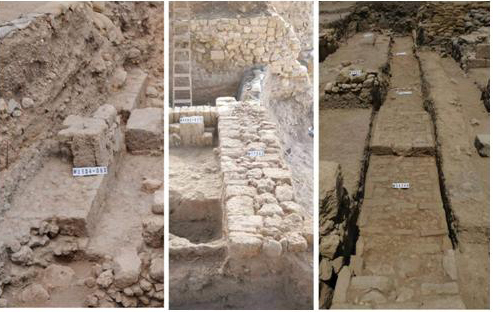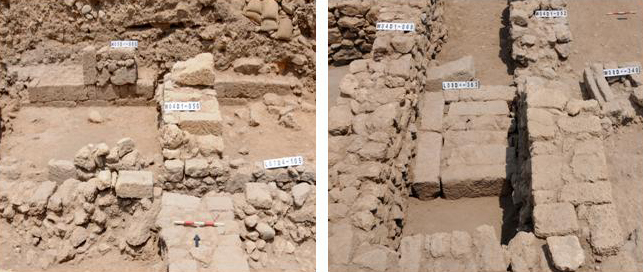Dor 2008 Preliminary Report
Roman Remains
Very little of this period was excavated this year. Work was confined to dismantling Roman walls and associated industrial installations in D4 and some in upper D5.
The Hellenistic Period
The main purpose for the opening of area D4 was to excavate a huge Hellenistic structure extending over much of the southwestern part of the mound. The first halls belonging to this building were uncovered as early as 1984 (Stern 1985) in area D1 (Figure 5), and the structure was (mistakenly) dubbed the “Persian Palace”. Following the re-opening of the area in 1996 (Stern et al. 2000), the structure was correctly dated to the Hellenistic period, but it was not till 2000 (Sharon et al. forthcoming) it was realized that the ‘PP’ is not an independent structure, but merely one wing of a much larger building – as it abuts the corner of a massive east-west wall (nicknamed “the big mother wall”), previously uncovered (and removed) along the northern edge of area D2. In 2004 – 2006 we followed the western edge of this building some 15 m. northwards – in the area called ‘upper D1’. By this time, the overall dimensions of the exposed part of the building were c. 25 (N-S) X 50 (E-W) m. and it was clear that the center of the building lay in the unexcavated area north of D2.
It was only in 2008, however, that architectural elements probably belonging to this structure were uncovered in area D4, in local phase D4/3. These consist of W05D4-060b - a wide foundation made of small ashlars in ‘box’ or ‘compartment building’ pattern, very similar to the south wall of the building – the original ‘big mother wall’ W17562, as well as to the extant portions of W26249 – the west wall of this wing of the structure. Joining W05D4-060 is W04D1-050.

Figure 3: (p08A-0177) W05D4-060 (left) W17562 (center) and W26249 (right).
The extant portions of this wall are probably Roman rebuilds of phases D4/1-2, but under them a wider phase, built of fine ashlars is beginning to appear. The last element is an enigmatic square feature built of large ashlars (W08D4-363) – reminiscent of the central pier in the westernmost hall of the “PP” building.

Figure 4: (p08A-0144) Left: W04D1-050 joining W05D1-060 and right: W08D4-363.

Figure 5: (p08A-0178) The palatial Hellenistic building, 2008 additions in blue
Before uncovering these remains in area D4 we dug through a series of Hellenistic fills of phases 2 and 3, very rich in pottery and other finds. Thus far, however, no floors reach any of the phase 3 walls. Moreover, when the top of W05D4-060 was uncovered, we also located what appears to be a foundation trench next to it. It is therefore possible that the structure was not preserved above foundation level.
Another open question is whether W05D4-060 marks the end of the structure, or does it extend further north. Excavation in ‘Upper D1’ revealed a Roman street running through AU – AS/17 (Stern 1985). If this street is built on a Hellenistic street – as is usually the case at Dor, and if this street continues through AR – AN/17-18, then it might mark the northern façade of the palatial structure.
One more find which deserves mention is a stone altar / statue base found in reuse when a Hellenistic wall was dismantled in area D2. Similar altars were found in Phoenician sites in the west in the Persian and Hellenistic periods – often with dedicatory inscriptions.
Figure 6: (p08A-0143) Stone Altar / Statue Base.
The Persian Period
Exposure of this period was limited this season, and is confined to D5 – east and west of the deep central section (Phase D5/6). Several floors and pits of this period were cleared this season. The architecture associated with these is in general, very degraded, and appears to be of residential insulea with thin walls built in the ashlar pier technique, as is quite usual at Dor.
Several special finds of this period deserve mention.
An eye belonging to a grotesque gorgon mask - this is the third fragment of such to be found at Dor – the two others were found in area D2 in the 90’s. The eyes on all three fragments are very similar, and all are larger than human, but are of different dimensions and so must have belonged to different-sized gorgonea.
Three epigraphic finds were made this season – all in Persian loci in area D5. One is a five-line Aramean ostracon, very worn and possibly illegible. The second is a ‘docket’ – a conical / triangular terra-cotta piece with a string-hole running through it and an Aramean inscription incised outside it. The last is the handle of an amphora with a stamp bearing several characters in the Cypro-Syllabic script. This is the second Cypro-Syllabic inscription to be found at Dor and one of the very few ever found outside the island.
- -- Table of Content -- |
- -- Top -- |
- -- Continue to Iron Age --